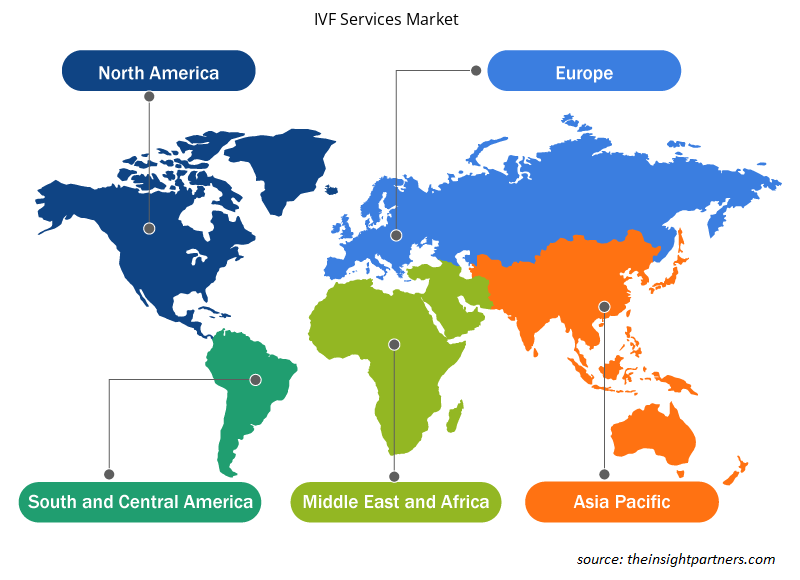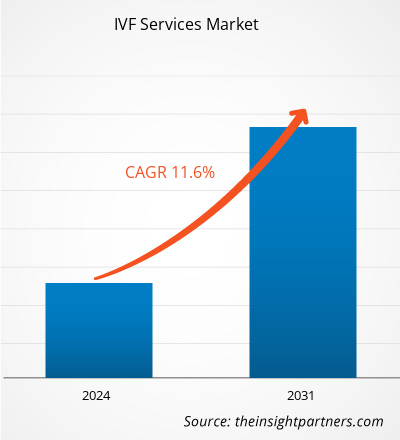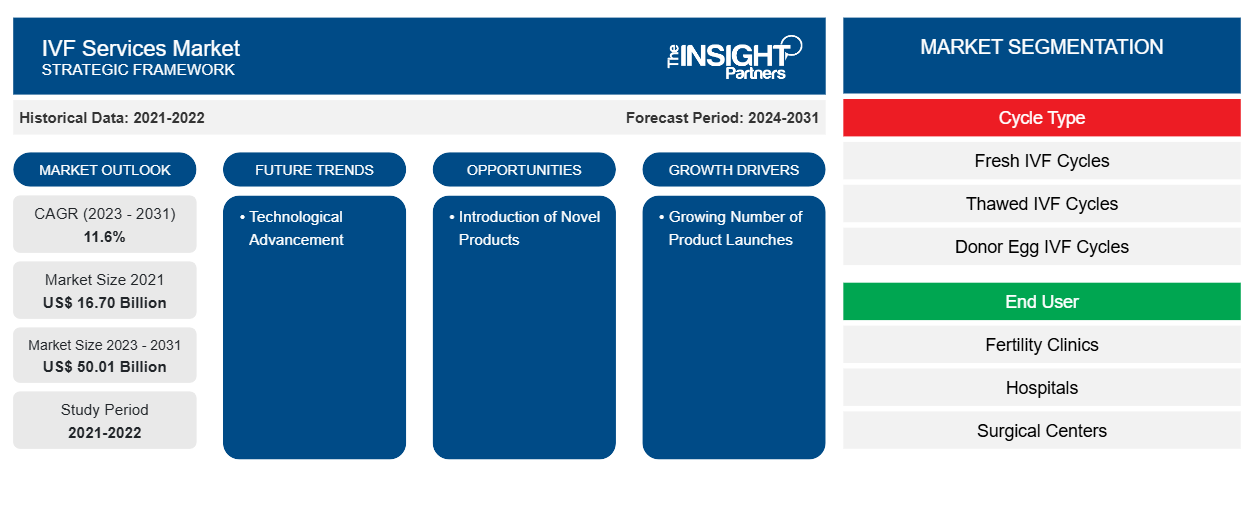Français La taille du marché des services de FIV a été estimée à 16,70 milliards USD en 2021 et à XX millions USD en 2023 et devrait atteindre 50,01 milliards USD d'ici 2031. On estime qu'il enregistrera un TCAC de 11,6 % jusqu'en 2031. L'augmentation des cas d'infertilité, l'augmentation du nombre de cliniques de fertilité et de services d'infertilité avec le soutien du gouvernement et l'intégration de l'intelligence artificielle dans la fécondation in vitro devraient rester les principales tendances du marché des services de FIV .
Analyse du marché des services de FIV
La FIV, ou fécondation in vitro, est une thérapie de fertilité dans laquelle les ovules sont prélevés dans les ovaires des femmes et fécondés avec du sperme à l'extérieur du corps. Cette étape comporte plusieurs étapes et peut être recherchée par des couples ou des individus souffrant de problèmes de fertilité. Actuellement, diverses cliniques et centres de FIV proposent des services de FIV dans le monde entier.
Le taux de fécondité est en baisse constante à l’échelle mondiale, en raison de divers facteurs, tels que la tendance croissante aux mariages tardifs et l’augmentation de l’infertilité liée à l’âge . Les taux de fécondité mondiaux devraient tomber à 2,4 enfants par femme d’ici 2030 et à 2,2 enfants par femme d’ici 2050. Environ 12 % des femmes de la tranche d’âge de 15 à 44 ans aux États-Unis ont eu des difficultés à tomber enceintes ou à mener leur grossesse à terme, quel que soit leur statut matrimonial. En outre, environ 6,0 % des femmes mariées âgées de 15 à 44 ans aux États-Unis ne sont pas en mesure de tomber enceintes après un an d’essai (infertilité). Ainsi, la baisse du taux de fécondité entraîne une augmentation substantielle de la demande de services de fécondation in vitro (FIV) qui influencent la fenêtre de fertilité chez les hommes et les femmes.
Aperçu du marché des services de FIV
Français L'incidence croissante de l'infertilité, le nombre croissant de cliniques de fertilité et de services d'infertilité avec le soutien du gouvernement, et le nombre croissant de lancements et de développements de produits. Cependant, le coût procédural élevé des techniques de reproduction et les risques associés au traitement de l'infertilité freinent la croissance du marché. Le marché mondial des services de FIV est segmenté par région en Amérique du Nord, Europe, Asie-Pacifique, Moyen-Orient et Afrique, et Amérique du Sud et centrale. La région européenne détient la plus grande part de marché, tandis que la région Asie-Pacifique est la région qui connaît la croissance la plus rapide. Des facteurs tels qu'une augmentation du traitement de l'infertilité par FIV et ART. Le soutien croissant du gouvernement par le biais de divers programmes, le nombre croissant de centres de fertilité dans les pays et la baisse du taux de fécondité chez les femmes sont susceptibles d'accroître la croissance du marché dans la région au cours des années de prévision.
Personnalisez ce rapport en fonction de vos besoins
Vous bénéficierez d'une personnalisation gratuite de n'importe quel rapport, y compris de certaines parties de ce rapport, d'une analyse au niveau des pays, d'un pack de données Excel, ainsi que d'offres et de remises exceptionnelles pour les start-ups et les universités.
- Obtenez les principales tendances clés du marché de ce rapport.Cet échantillon GRATUIT comprendra une analyse de données, allant des tendances du marché aux estimations et prévisions.
Facteurs moteurs et opportunités du marché des services de FIV
Nombre croissant de lancements de produits en développement pour favoriser le marché
Les entreprises du marché des services de FIV adoptent un comportement de recherche et développement accru pour introduire des produits plus innovants. Les nouveaux cycles de FIV décongelés, les cycles de FIV avec don d'ovules, les systèmes de micromanipulation et les incubateurs permettent l'adoption de technologies cellulaires avancées, qui renforcent les résultats des procédures. En janvier 2021, Royal Philips, un leader mondial des technologies de la santé, a déclaré un partenariat pluriannuel avec Merck, une société scientifique et technologique de premier plan, pour développer des solutions numériques de qualité clinique pour un traitement de fertilité hautement personnalisé. Un nombre croissant de lancements de produits, de fusions et d'acquisitions et de développements devraient stimuler le marché des services de FIV.behaviour to introduce more innovative products. The new thawed IVF cycles, donor egg IVF cycles, micromanipulator systems, and
Conduite de campagnes de sensibilisation – Une opportunitéle marché des services de FIV
Les campagnes de sensibilisation contribuent de manière substantielle à accroître la portée des technologies et des thérapies de FIV auprès des populations. De telles campagnes présentent également un potentiel considérable pour la promotion de nouveaux centres de FIV, l'échange d'informations et les discussions. Par exemple, la première semaine de novembre 2022 a été célébrée comme la Semaine européenne de la fertilité 2022. Cette semaine a été observée pour inviter les décideurs politiques de toute l'Europe à améliorer l'accès et la qualité des traitements existants contre l'infertilité. En outre, des organisations, telles que Fertility Europe, prennent des mesures concrètes pour diffuser les bonnes informations sur le traitement de l'infertilité. En 2022, l'EFW consacrera toute la semaine à sensibiliser le patient au parcours de fertilité et aux difficultés auxquelles il doit souvent faire face. Ainsi, la conduite de campagnes de sensibilisation appropriées devrait fournir des plateformes de présentation solides aux entreprises, offrant ainsi des opportunités de croissance pour propulser les revenus au sein de l'écosystème dynamique.EFW will dedicate the whole week to bringing awareness to the patient's fertility journey and the difficulties they often have to deal with. Thus, conduction of appropriate awareness campaigns is expected to provide robust showcasing platforms for companies, thereby offering growth opportunities to propel revenues within the dynamic ecosystem.
Analyse de segmentation du rapport sur le marché des services de FIV
Les segments clés qui ont contribué à l’élaboration de l’analyse du marché des services de FIV sont le type de cycle et l’utilisateur final.
- En fonction du type de cycle, le marché des services de FIV est divisé en cycles de FIV, cycles de FIV décongelés et cycles de FIV avec ovules de donneuse. Le segment des cycles de FIV frais détenait la plus grande part du marché en 2023 ; en outre, le même segment devrait enregistrer le TCAC % le plus élevé du marché au cours de la période de prévision.
- En termes d'utilisateurs finaux, le marché est segmenté en hôpitaux, cliniques de fertilité, centres chirurgicaux et instituts de recherche clinique. Le segment des centres de fertilité détenait la plus grande part du marché en 2023 ; en outre, le segment devrait enregistrer le TCAC le plus élevé du marché au cours de la période 2023-2031.
Analyse des parts de marché des services de FIV par zone géographique
Français La portée géographique du rapport sur le marché des services de FIV est principalement divisée en cinq régions : Amérique du Nord, Asie-Pacifique, Europe, Moyen-Orient et Afrique, et Amérique du Sud/Amérique du Sud et centrale. L'Amérique du Nord a dominé le marché des services de FIV après l'Europe. On constate une augmentation du taux de traitement de l'infertilité dans tout le pays. D'après le rapport 2018 des CDC sur les taux de réussite des cliniques de fertilité, 306 197* cycles d'ART ont été réalisés dans 456 cliniques déclarantes aux États-Unis en 2018, ce qui a donné lieu à 73 831 naissances vivantes (accouchements d'un ou plusieurs nourrissons vivants) et 81 478 nourrissons nés vivants. L'Amérique du Nord détenait la plus grande part en 2023. Une inclination vers les produits techniquement avancés et la présence d'acteurs du marché mondial sont des facteurs contribuant à la domination du marché nord-américain des services de FIV. L'Asie-Pacifique devrait connaître le TCAC le plus élevé dans les années à venir.
Aperçu régional du marché des services de FIV
Les tendances et facteurs régionaux influençant le marché des services de FIV tout au long de la période de prévision ont été expliqués en détail par les analystes d'Insight Partners. Cette section traite également des segments et de la géographie du marché des services de FIV en Amérique du Nord, en Europe, en Asie-Pacifique, au Moyen-Orient et en Afrique, ainsi qu'en Amérique du Sud et en Amérique centrale.

- Obtenez les données régionales spécifiques au marché des services de FIV
Portée du rapport sur le marché des services de FIV
| Attribut de rapport | Détails |
|---|---|
| Taille du marché en 2021 | 16,70 milliards de dollars américains |
| Taille du marché d'ici 2031 | 50,01 milliards de dollars américains |
| Taux de croissance annuel composé mondial (2023-2031) | 11,6% |
| Données historiques | 2021-2022 |
| Période de prévision | 2024-2031 |
| Segments couverts | Par type de cycle
|
| Régions et pays couverts | Amérique du Nord
|
| Leaders du marché et profils d'entreprises clés |
|
Densité des acteurs du marché : comprendre son impact sur la dynamique des entreprises
Le marché des services de FIV connaît une croissance rapide, tirée par la demande croissante des utilisateurs finaux en raison de facteurs tels que l'évolution des préférences des consommateurs, les avancées technologiques et une plus grande sensibilisation aux avantages du produit. À mesure que la demande augmente, les entreprises élargissent leurs offres, innovent pour répondre aux besoins des consommateurs et capitalisent sur les tendances émergentes, ce qui alimente davantage la croissance du marché.
La densité des acteurs du marché fait référence à la répartition des entreprises ou des sociétés opérant sur un marché ou un secteur particulier. Elle indique le nombre de concurrents (acteurs du marché) présents sur un marché donné par rapport à sa taille ou à sa valeur marchande totale.
Les principales entreprises opérant sur le marché des services de FIV sont :
- Soins de santé Max,
- Bloom FIV,
- CCRM Fertilité,
- OXFORD FERTILITÉ,
- Créer la santé (Créer la fertilité),
- Médicover,
Avis de non-responsabilité : les sociétés répertoriées ci-dessus ne sont pas classées dans un ordre particulier.

- Obtenez un aperçu des principaux acteurs du marché des services de FIV
Actualités et développements récents du marché des services de FIV
Le marché des services de FIV est évalué en collectant des données qualitatives et quantitatives après des recherches primaires et secondaires, qui comprennent d'importantes publications d'entreprise, des données d'association et des bases de données. Voici une liste des évolutions du marché des services et des stratégies de FIV :
- En avril 2023, Cryoport, Inc., l'un des principaux fournisseurs mondiaux de solutions de chaîne d'approvisionnement innovantes à température contrôlée pour l'industrie des sciences de la vie et un leader des solutions de chaîne d'approvisionnement pour les marchés de la médecine de la reproduction, a annoncé un accord pluriannuel avec Inception Fertility. Inception Fertility exploite The Prelude Network® (Prelude), le réseau de centres de fertilité axé sur la technologie le plus important et à la croissance la plus rapide en Amérique du Nord. (Source : Prelude Fertility, communiqué de presse, 2024)
- En avril 2023, The Prelude Network, l'un des principaux fournisseurs de services complets de fertilité en Amérique du Nord, a annoncé un partenariat exclusif avec Future Family (FF), une plateforme nationale de création de famille avec des plans financiers flexibles et des services de soutien de conciergerie. Le partenariat vise à élargir l'accessibilité financière aux services de fertilité haut de gamme, en offrant aux patients davantage d'options financières et une compréhension claire des coûts de traitement. Source : (Prelude Fertility, Communiqué de presse, 2024)
Rapport sur le marché des services de FIV : couverture et livrables
Le rapport « Taille et prévisions du marché des services de FIV (2021-2031) » fournit une analyse détaillée du marché couvrant les domaines ci-dessous :
- Taille du marché et prévisions aux niveaux mondial, régional et national pour tous les segments de marché clés couverts par le périmètre
- Dynamique du marché, comme les facteurs moteurs, les contraintes et les opportunités clés
- Principales tendances futures
- Analyse détaillée des cinq forces de PEST/Porter et SWOT
- Analyse du marché mondial et régional couvrant les principales tendances du marché, les principaux acteurs, les réglementations et les développements récents du marché
- Analyse du paysage industriel et de la concurrence couvrant la concentration du marché, l'analyse de la carte thermique, les principaux acteurs et les développements récents
- Profils d'entreprise détaillés
- Analyse historique (2 ans), année de base, prévision (7 ans) avec TCAC
- Analyse PEST et SWOT
- Taille du marché Valeur / Volume - Mondial, Régional, Pays
- Industrie et paysage concurrentiel
- Ensemble de données Excel
Rapports récents
Témoignages
Raison d'acheter
- Prise de décision éclairée
- Compréhension de la dynamique du marché
- Analyse concurrentielle
- Connaissances clients
- Prévisions de marché
- Atténuation des risques
- Planification stratégique
- Justification des investissements
- Identification des marchés émergents
- Amélioration des stratégies marketing
- Amélioration de l'efficacité opérationnelle
- Alignement sur les tendances réglementaires





















 Obtenez un échantillon gratuit pour - Marché des services de FIV
Obtenez un échantillon gratuit pour - Marché des services de FIV